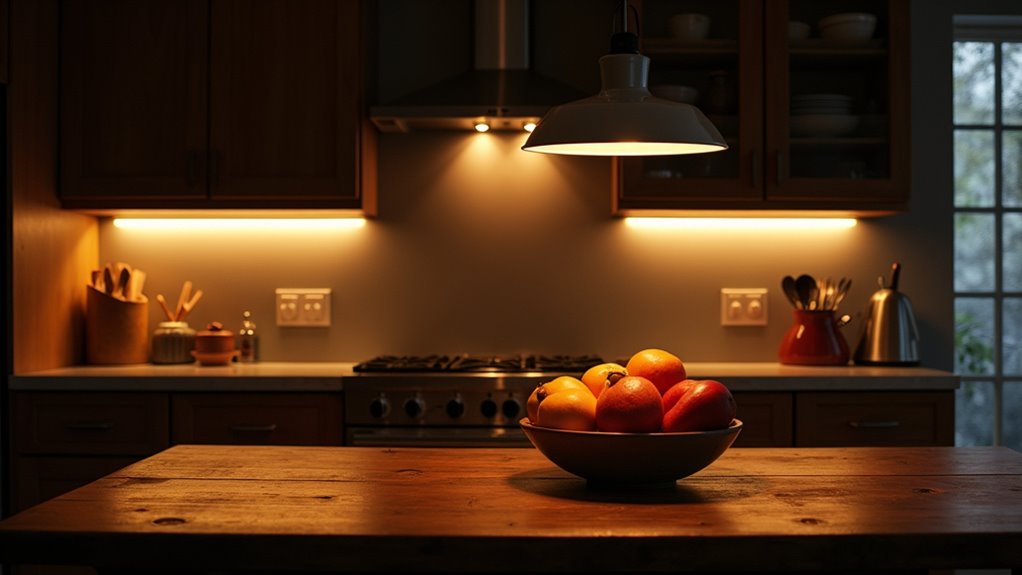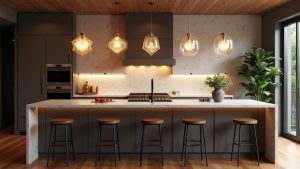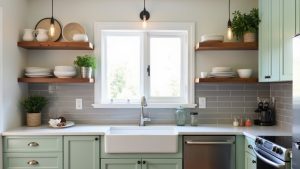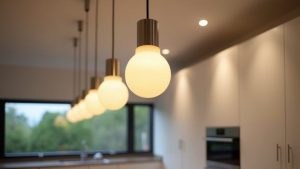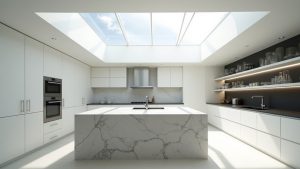To brighten a dark kitchen, first assess the space and identify key areas needing illumination. Next, select diverse fixtures like recessed lights and under-cabinet LEDs, choosing warm or neutral tones for ambiance. Finally, layer the lighting by combining ambient, task, and accent sources to create a visually appealing atmosphere. With these steps, the kitchen transforms into a vibrant hub. There’s so much more to explore for achieving the perfect lighting balance in your culinary space.
Key Takeaways
- Assess the kitchen layout to identify dark areas and key tasks requiring focused lighting for improved visibility.
- Incorporate multiple light sources, such as recessed lights and under-cabinet fixtures, to create layered illumination throughout the space.
- Choose energy-efficient LED bulbs in the 3500K-4100K range for accurate task lighting without compromising a welcoming atmosphere.
- Position fixtures strategically above work zones, ensuring adequate brightness in cooking and prep areas while minimizing shadows.
- Regularly evaluate and upgrade your lighting plan to adapt to changing kitchen needs and maintain optimal brightness.
Assess Lighting Needs and Kitchen Characteristics

Assessing lighting needs and kitchen characteristics serves as the foundation for an effective illumination strategy. Accurate kitchen measurements, including total square footage, provide critical insights for creating a tailored lighting plan. Identifying dedicated task areas—such as countertops, cooking zones, and islands—is essential, as these spaces require intensified lighting to support various culinary activities. Additionally, understanding the shape and architectural features, such as ceiling height and cabinetry layout, highlights potential challenges with light distribution and shadows. General ambient lighting typically demands 20-50 lumens per square foot, while task areas necessitate a higher output of 50-80 lumens to ensure safety and efficiency. Incorporating functional under-cabinet lighting further enhances brightness in your kitchen for effective workspace illumination. This thoughtful assessment enables homeowners to create a well-lit, functional kitchen tailored to their specific needs. This guide provides insights on designing, planning, and implementing kitchen lighting, ensuring that all lighting types are effectively integrated for optimal results. Moreover, considering the option of adjustable lights can further enhance flexibility in achieving the desired illumination in your kitchen space.
Select Appropriate Light Sources and Fixtures
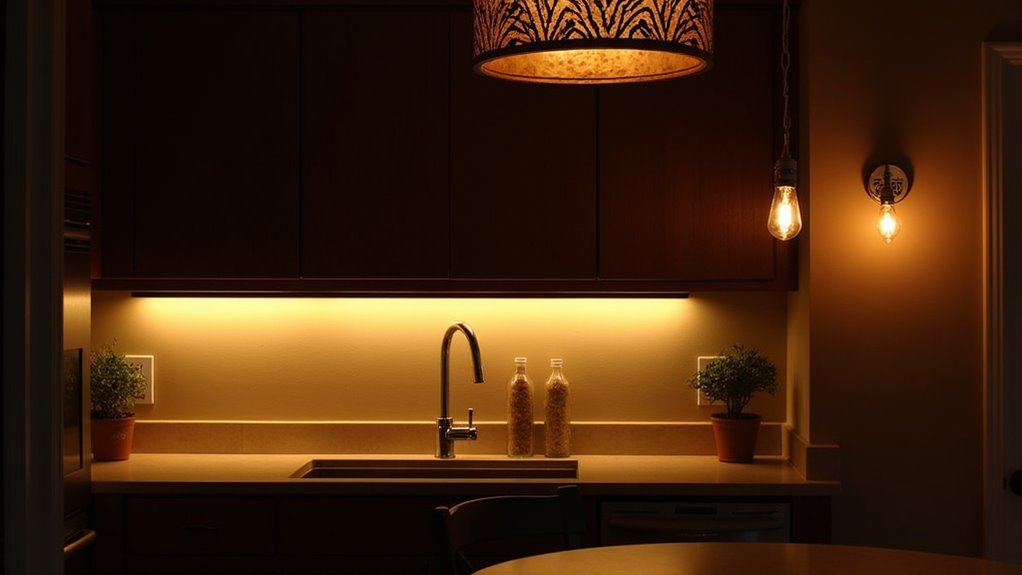
After understanding the kitchen’s unique lighting needs and characteristics, the next step involves selecting the right light sources and fixtures to achieve a balanced and functional illumination scheme.
Opting for diverse fixture styles can enhance both functionality and aesthetics. Flush-mounted ceiling lights cater to spaces with lower ceilings, while chandeliers and pendant lights add elegance, ideal for dining or countertop areas.
Choosing appropriate light color is crucial; neutral white (3500K to 4100K) is best for accuracy, while warmer tones (2700K to 3000K) create a cozy atmosphere. Incorporating Cool White LED Panels enhances visibility, ensuring the kitchen is well-lit for food preparation tasks.
The choice of light color significantly impacts your kitchen, balancing precision with warmth for a welcoming vibe.
Incorporating recessed and under-cabinet lighting enhances visibility and ambiance, while LED bulbs offer energy efficiency and longevity.
Careful selection of these elements ensures a beautifully lit kitchen suited for various tasks.
Optimally Position and Layer Lighting
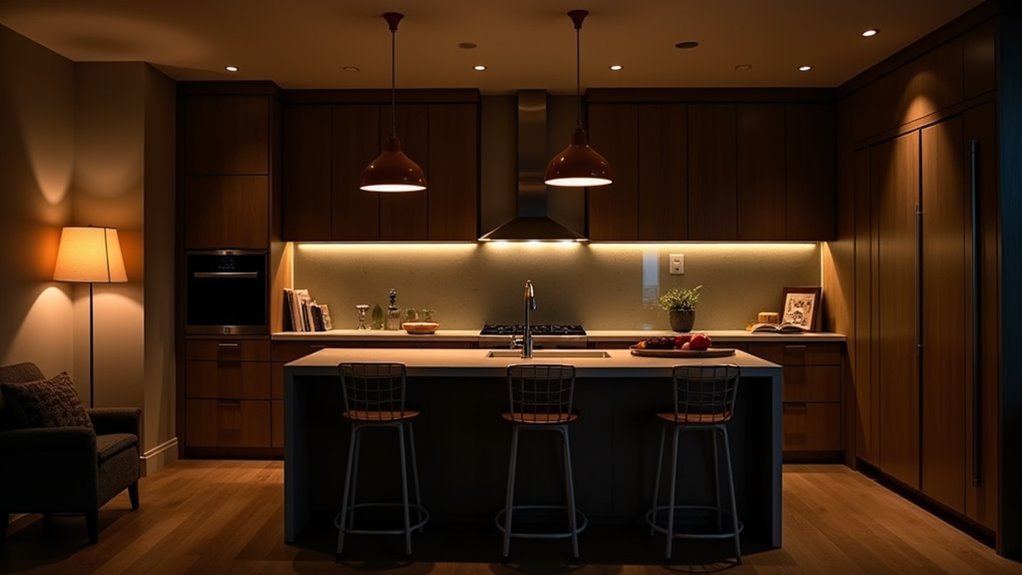
Effective lighting transforms a kitchen from a functional workspace into an inviting culinary haven. To achieve this, understanding layer placement is crucial.
Ambient lighting provides overall illumination, often via overhead fixtures like recessed lighting, while task lighting focuses on specific areas, such as under-cabinet lights illuminating countertops.
Accent lighting enhances visual appeal, using fixture styles like pendant lights to create focal points over islands.
Incorporating vertical and horizontal layering techniques adds dimension; pendant lights can hang at varying heights while track lighting highlights features below.
This strategic placement not only reduces shadows but also defines zones for cooking, dining, and socializing. Additionally, embracing layered lighting allows for a multifunctional space, transforming the kitchen into a hub for both cooking and entertaining.
